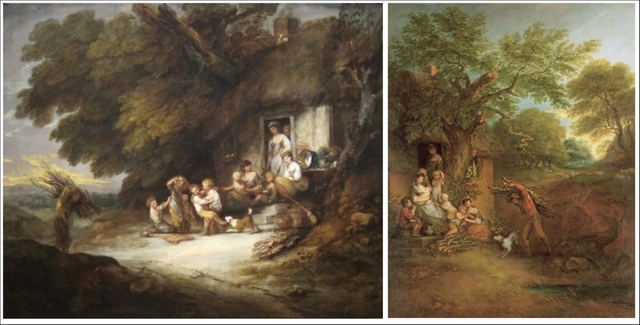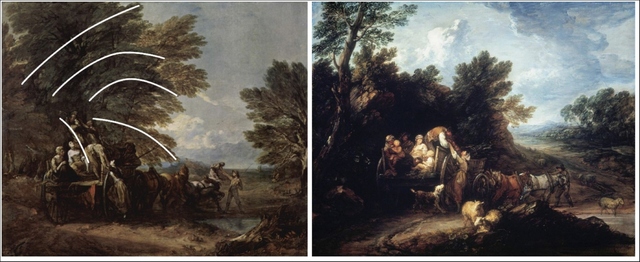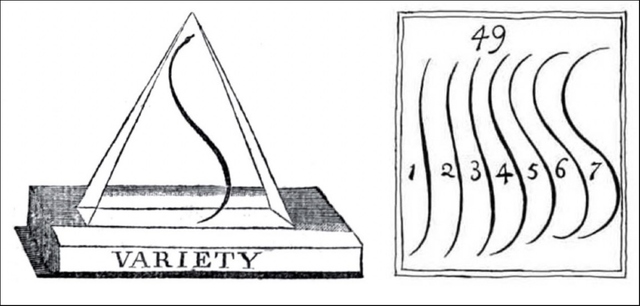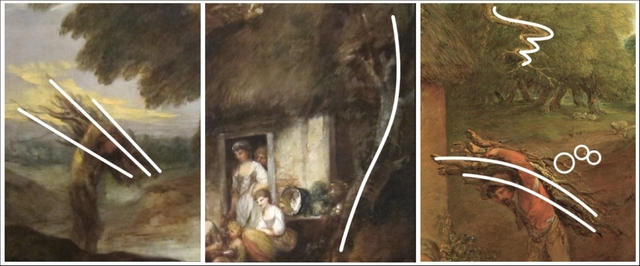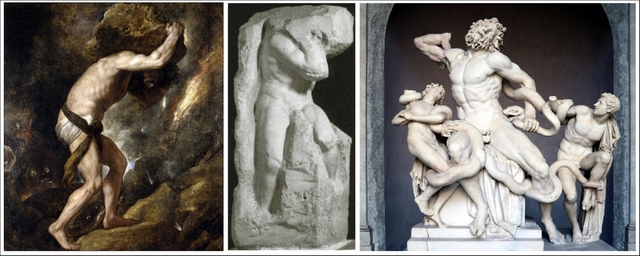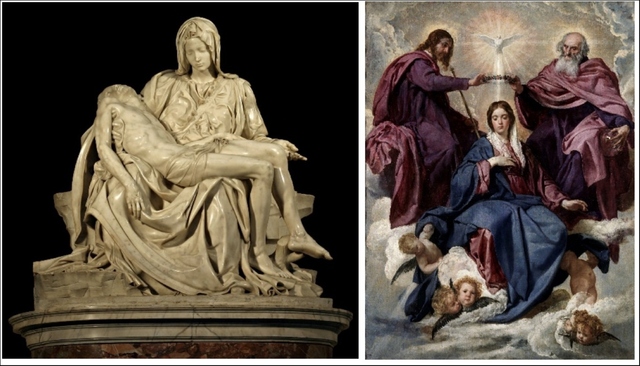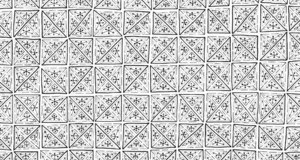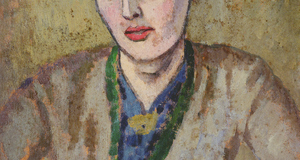Fragile Aesthetics: The Problematics Behind Thomas Gainsborough's Landscape Paintings
By
2022, Vol. 14 No. 04 | pg. 1/1 AbstractThe 17th and 18th centuries saw a wide proliferation of aesthetic discourse through which the picturesque emerged to capture the type of beauty derived from the exchange of in vivo vigor for the spirit of artistic medium. While the metaphysical project of 18th century aesthetic theory masquerades as apolitical, placing Thomas Gainsborough’s landscape paintings in dialogue with picturesque beauty reveals an underlying anxiety of peasant encroachment and class conflict. This paper parses the complex interplay between the “smooth” and the “rough” in Gainsborough’s c.1778 and c.1772-74 Cottage Door works, and 1767 and c.1784 renditions of The Harvest Wagon, with particular attention to the subjects of masculine labor, cherubim youth, and maternal sanctity. Considering Gainsborough’s paintings as works of picturesque beauty reveals “high” art’s false preoccupation with political reality. Such aesthetics ultimately prioritize quasi-mindless aesthetic rumination over sincere accounts of peasant life. Thomas Gainsborough’s landscape paintings portray the anthropogenic presence of peasant life concurrent to the “natural”[1] English countryside. The aestheticization of peasant life emphasizes the picturesque dimension of Gainsborough’s works.[2] Defined by Edmund Burke and William Gilpin, the aesthetics of the picturesque privilege the value of productive life itself. In doing so, opposed to the beautiful or sublime,[3],[4] the picturesque “render[s] with spirit” (Gilpin 16). The picturesque beauty of artistic works can be understood in terms of the intrinsic flattening of in-vivo scenes that takes place during representation. The picturesque object regains the dynamism lost during the static artistic rendering by generating spirit from the “exhibit[ion] [of] the graces” of the artistic medium itself (Gilpin 14). Gilpin’s focus on innate artistic beauty precludes politics from the picturesque. As such, it is tempting to view Gainsborough’s dialogue with the picturesque as removed from 18th century aristocratic class anxiety. Nevertheless, in Gainsborough’s c.1778 and c.1772-74 Cottage Door works (Fig. 1 and Fig. 2), and in his 1767 and c.1784 renditions of The Harvest Wagon (Fig. 3 and Fig. 4),[5] the complex negotiation between the “smooth” and “rough” subject – the former capturing beauty of real objects, giving the “eye delight[] in gliding smoothly over a surface,”[6] the latter referencing that “which makes objects chiefly pleasing in painting”[7] – injects class anxiety into his picturesque aesthetics (Gilpin 4, 6).[8] Such political injection complicates purist aesthetic theories, such as Gilpin’s picturesque beauty and William Hogarth’s Analysis of Beauty (1753). Gilpin and Hogarth view beauty as an innate metaphysical phenomenon beyond the influence of social politics; exemplifying the politically transcendent nature of these aesthetic theories is Hogarth’s geometric abstraction of the beautiful (Fig. 5a and Fig. 5b).[9] Nevertheless, Gainsborough’s negotiation between politics and aesthetics doubles the aristocratic appeal of his works: beyond the intuitive experience of aesthetic beauty, Gainsborough’s works present an aesthetic solution to the moral problem of conflict between aristocratic exuberance and impoverished peasant life. Fig. 1 & 2.Fig. 3 & 4. Fig. 5a & 5b. Despite this essay’s attempt to address the contradictory interplay between Gainsborough’s picturesque aesthetics and aristocratic class anxiety, Gainsborough’s works are nonetheless novelly class-conscious, addressing the “lower” artistic topic of peasant life. The 16th century Italian artistic hierarchy places historical paintings and portraiture over the genre painting.[10] Not until 19th century Realism do genre paintings of the working class take artistic center stage. While Gilpin theorizes the aesthetic potential of labor and peasantry, his examples of the picturesque are pulled exclusively from “high” works. For example, while theoretically acknowledging that the “worn-out cart-horse” more poignantly registers artistic “essence” than the “manicured Arabian,” Gilpin uses Virgil’s portraits of Venus and Ascanius,[11] Milton’s depiction of Eve,[12] Homer’s idea of Jupiter,[13] and Laocoön and His Sons,[14] to exemplify the picturesque (Gilpin 14). Regarding Gilpin’s objective of quantifying picturesque beauty, the stable and indisputable beauty of such “high” classical subjects makes them appealing examples. The picturesque beauty of low subjects is theoretically possible, yet their omission from Gilpin’s examples highlights the controversy and political hesitance around subject expansion beyond the 16th century Italian norm. As such, Gainsborough’s The Harvest Wagon and Cottage Door works represent a significant shift in the politics of artistic subject matter, introducing the working life genre painting into the picturesque high arts scene. The depiction of the male laborers places the works in conversation with the picturesque. The picturesque’s prioritization of the unrefined subject is actualized by Gainsborough’s illustration of the male laborers in Figures 1 and 2.[15] The branches the men carry are more detailed than the surrounding flora – however, the living branches are more “beautiful” in a Hogarthian sense.[16] In Figure 1, while the tree immediately to the right of the hut is in the same perspective plane as the man, the terminal ends of the branches in the load are visible (see Fig. 6a). Yet, neither the referenced tree (see Fig. 6b), nor any of the surrounding flora are painted with such granularity. Nevertheless, the branches the man carries are relatively linear whereas the tree to the right of the hut follows a polynomial curve,[17],[18] seemingly of the same family of serpentine curves as those Hogarth calls the “line[s] of beauty” (Fig. 5b). Likewise, in Figure 2, the branching complexity of the load contrasts the intricacy of the surrounding flora. The load contains triple successive forks,[19] while the surrounding flora contains at most two. Rather than using branch complexity to build beauty, the living branches embrace Hogarth’s serpentine line, where dynamic bending and curvature “lead[] the eye on a wanton kind of chase”[20] (Hogarth 33). In contrast, the branches of the load are more linear.[21] Both paintings include highly detailed branch loads which emphasize the magnitude of the carried weight. Yet, as less intricately beautiful than the living flora,[22] the labor of lifting the loads is separate from the beauty of the natural landscape. Fig. 6a, 6b, 6c. By representing the quantitative weight of the loads, Gainsborough emphasizes the act of labor itself. Compared to portrait works contemporary to Gainsborough’s epoch, the male laborers offer the viewer no desire to fix some “fleeting form” of beauty. Rather, their depictions draw attention to the raw presence of the laboring peasantry (Gilpin 15). Here, the laboring peasant man is analogous to the “worn-out cart-horse” (Gilpin 14). For Gilpin, “we admire the horse, as a real object, the elegance of his form; the stateliness of his tread; the spirit of all his motions; and the glossiness of his coat” (Gilpin 14). However, as an object of representation, we admire more the picturesque object – the “worn-out cart-horse, the cow, the goat, or the ass; whose harder lines, and rougher coats, exhibit more the graces of pencil” (Gilpin 14). Gainsborough’s works similarly create a representative space, distinct from the real, in which the laboring peasant has the unique opportunity to be admired equally to the subject of a grand portraiture. Even so, such representative space relies on a distinction between aesthetic engagement with labor through manifold detail and aesthetic engagement with natural flora through simplistic intricacy. In consequence, aesthetic engagement with labor is relegated to a lesser theoretical form than the engagement with the more traditional natural subject. The lack of facial detail of the male subjects aestheticize labor without consideration of personhood.[23] While the subject of labor is picturesque, the peasant man as subject falls short of picturesque beauty. Gilpin notes that the roughness of facial texture and the depiction of cosmetic irregularities results in the “human face [at the] brightest form of picturesque beauty” (Gilpin 10). Figure 1 places labor as its central subject and thus the readiest candidate for picturesque beauty, yet the man’s facial features are shrouded in such a manner that no discernable emotion or facial features are visible (see Fig. 5a). In Figure 2, the man’s facial features are more pronounced. His pupils are nevertheless undiscernible, unlike for the woman to his immediate left. Furthermore, the inclusion of the rosy cheeks and detailed mouths of the women and children highlight the absence of such features in the man. Consequently, the viewer is invited to consider the women and children as dynamic subjects, with “dignity of character, force of expression, […], energetic meaning, […] [and] the bewitching smile of youth,” while the male subject lacks such human characteristics (Gilpin 10). The distinction between the personhood of the man and the women/children defines the bounds of Gainsborough’s discussion of peasant labor. While innovative in his engagement with the atypical subject of peasant labor, Gainsborough markedly distances his work from an engagement with labor psychology, leaning on labor as an agnostic abstraction. The flattening of the male labor subject’s color palette further detaches labor from the individual. In Figure 1, the hue of the man’s torso mirrors the sky immediately behind him and the color of his trousers is of the same palette as the surrounding earth; this differs from the artificial and contrasting whites and yellows used to paint the women and children. The man in Figure 2 similarly blends into the natural landscape. The hue of the man’s trousers in Figure 2 closely matches the trodded dirt path, in contrast to the blues and whites of the women, children, and dog which stand out from the surrounding earth. The beauty of the picturesque object derives from the “rich colours that arise [] from it’s broken surface,” and this richness in color lends the artist “the very essence of [their] art” (Gilpin 21). Without such chromatic richness, Gainsborough’s male subjects appear less real than any of the children (particularly in Figure 1) whose wide range of color, per Gilpin, infuses the children with artistic essence. The flattening of the male subject’s color dynamism removes precisely that element which Gilpin attributes to the “essence of [] art” (Gilpin 21). The labor subject prompts aesthetic engagement through the picturesque, yet the absence of the laborer’s picturesque beauty construes labor as person-less. The peasant laborer’s lack of picturesque beauty seems to demand an alternative characterization of the subject’s aesthetic engagement. For this, the sublime is potentially useful. The picturesque is present within Gainsborough’s works through the woman and children, the subject of unrefined masculine labor, and the subject of peasant life. Building off Burke, Gilpin understands the picturesque as the middle ground between the beautiful and the sublime. With the presence of the picturesque and the beautiful (the later ascribed to the natural serpentine flora and Madonna-esque women), it seems necessary for the works to hold some sublime quality for the picturesque to be a middle-ground between the two. It is tempting to characterize the laborers as sublime, as their strength demonstrated through the lifting of the bounteous branch loads conveys a degree of greatness in line with Burke’s notion of the sublime. Even so, the critical distance between sublime pleasure and labor dampens aesthetic enjoyment of peasant labor. The quantitative weight carried by the men in Figures 1 and 2 evokes Titian’s Sisyphus (1548-49, Fig. 7) and Michelangelo’s Atlas Slave (1525-30, Fig. 8). The laborious yet magnificent activity in the Titian and Michelangelo are constructed by the size of both works (93 x 85 in. and 9 ft. tall, resp.) and dynamic definition of muscular physique – the viewer admires the feats of Sisyphus and Atlas because of the prevail of muscular strength over copious weight. Such elements mirror Gilpin’s descriptions of the picturesque beauty of Laocoön and His Sons – the representation of “strong muscular motion” of a “figure in strong momentary action” (see Fig. 9) (Gilpin 13). Beyond the picturesque beauty of the muscular action of Sisyphus and Atlas, their larger-than-life artistic presence – conveying greatness and fear – simultaneous to the fictional villainy of the figures, allows a viewing experience of sublime pleasure.[24] The overwhelming greatness, and subsequent sublime beauty, in the Titian and Michelangelo stems from the tension between human body and tremendous weight. While Gainsborough’s laborers conquer the weight they carry, admiration of the human body is downplayed through the laborers’ lack of facial detail and muscular definition. Because of the lack of bodily picturesque beauty of the laborers, there is little physical tension between body and weight. Any tension, if existent, remains exclusively theoretical as tension between weight and an abstraction of labor. As such, Gainsborough’s slight evocation of sublimity remains minimally generative of aesthetic beauty. Fig. 7, 8, 9 While labor is removed from individuality in Figures 1 and 2, the drunk in Figure 3 aestheticizes peasant life concurrent to the peasant as individual, thus presenting the picturesque beauty of peasant life. The curvature of the highest standing man in Figure 3 is perpendicular to the contours of the tree immediately behind him[25]. This interruption of floral contours makes the man in Figure 3 stand out from his surrounding landscape. In contrast, the color similarity between the men and earth in Figures 1 and 2 absorbs them as part of their surrounding landscape. It is precisely the angular non-conformity of the man in Figure 3 that results in a prioritization of the “rough” over the “smooth” (Gilpin 8). By imbuing the body of the peasant man with picturesque beauty, Figure 3’s vibrant and focal depiction of peasant life produces an energetic human spirit that is markedly distinct from the harmonious and tranquil affectual engagement sponsored by the natural background. Moreover, the animated motion of the white horse – its intense range of highlights and shadows and vibrant muscular definition – similarly sponsors picturesque beauty. The overwrought picturesque beauty in Figure 3 hinges on depictions of the raw motions of peasant life. As objects with picturesque beauty, the body, along with the subsequent political force of the peasant, is given aesthetic recognition. The presence of the men in Figures 1 and 2 is dampened through their harmonious integration into the surrounding landscape. In this way, the subjects of labor are aesthetically equivalent to natural objects – present, but without body politics. In contrast, in Figure 3, peasant activity is inextricably linked to the peasant body and is thus necessarily politically real. Aesthetic appreciation of the 1767 work requires the viewer’s engagement with the political reality of peasant life which, for the implied aristocratic viewer, is synonymous to engagement with anxiety over class conflict. The aristocratic desire to psychologically suppress such conflict demands a barrier to the aesthetic enjoyment of Figure 3. The c.1784 (Fig. 4) revision’s removal of those anxiety provoking picturesque elements of peasant life illustrates the prioritization of aristocratic political anxiety over aesthetic enjoyment in a pure sense[26]. Even with the picturesque’s theoretical desire to depict course and raw scenes, the contrast between the roughness of the artistic subjects in Figures 3 and 4 reveals the underlying desire to portray the “rough” in line with aristocratic values (Gilpin 8). While labor is abstracted from the peasant as person, the personhood of the children is highlighted. The children in Figure 1 are abundantly cherubic – their blonde hair, white clothes, and playful poses highlight their innocence. Despite the cherubic “smooth” depiction, the children’s facial details are expressive, particularly in how the faces produce shadows when struck by the light vector directed at the front of the cottage. Gilpin notes that “the beauty [] of catching light arises from the roughness of objects” (Gilpin 21). Such dynamic use of lighting grants the children picturesque beauty more generally denied to the laboring men in Figures 1 and 2. The cherub as a subject is connotatively non-picturesque – their position as divine religious subject, the highest form of 16th Century Italian art, separates the cherub from the “roughness” the picturesque theoretically requires (Gilpin 8). Even so, their present picturesque beauty in the Gainsborough, concurrent to the non-picturesque beauty of the man, imbues the former with a degree of artistic “essence” that makes the children more real than the laboring men (Gilpin 21). As such, the viewer is invited to associate the blissful merriment of childhood with the natural human condition of the young peasant. The social roles of the children in Figures 1 and 2 reduce the reality of peasant life to a depiction aligned with aristocratic values. The sanctity of the child as a developing mind condenses as an aristocratic value contemporary to Gainsborough’s epoch. Gainsborough draws on Locke’s notion of the tabula rasa, suggesting that learning inheres not in the mind itself but is molded by education. The child second to the farthest left in Figure 1 and the child to the farthest left in Figure 2 both appear capable of physical labor. However, their position interchangeable with the other younger children proposes a concept of childhood that removes the child from labor not on the premise of physical ability, but on the categorization of the developing child. Such a notion of childhood was not available to the peasant class, where labor is equated to a means of survival. Consequently, Gainsborough’s depiction of childhood transposes the aristocratic child onto the peasant child, negating the unique labor experience of the latter. Gainsborough’s depictions of the women in the paintings invoke the Virgin Mary, idealizing the maternal peasant along religious lines. The maternal pose of the seated women in Figures 1, 2, and 4 mirrors the Madonna’s pose in Michelangelo’s Pietà (1498-99, Fig. 10) and in Velázquez’s The Coronation of the Virgin (1641-44, Fig. 11). Concurrent to the crude hut and scene of labor, the parallels to the Madonna construe femininity as incorruptibly pure. Moreover, in Figures 2 and 4, light is noticeably directed at the seated women. Such highlighting parallels the regal luminosity of the Virgin Marry in the Velázquez (Fig. 11). The seated woman in Figure 3, however, lacks such holy lighting and sanctimonious seat, painted with a deathly pale hue and outstretched pose[27]. The titles of the Michelangelo and Velázquez emphasize the qualities of femininity that Gainsborough seeks to evoke: “Pietà,” Italian for pity, and “virgin.” Both characterizations contrast the depiction of the woman in Figure 3; the woman’s tattered apparel and her proximity to drunken exuberance removes her character from the image of the pious pitiful virgin. Figure 3’s ambiguous distance from the incorruptible and pure constructions of femininity promoted in Figures 1 and 2 accounts for the referenced woman’s replacement by the overtly Madonna-like woman in the c.1784 rendition of The Harvest Wagon (Fig. 4). Fig. 10, 11 In depicting peasant life, Gainsborough is necessarily faced with the problem of portraying aristocratic values in a non-aristocratic setting. The differences in the experience of labor between the aristocracy and peasantry intrinsically provoke anxiety over class conflict when the subject of labor is depicted in a scene of artistic leisure. Such anxiety magnifies to a potentially neurotic threshold in the contemporary context of the French Revolution, where the Third Estate’s desire for unilateral and total reform encompass all areas of society, including attacks on the bourgeois valuations of femininity and childhood. Gainsborough’s works present an aesthetic solution to the threat of rampant French-Revolution-styled progressivism. By representing labor, Gainsborough acknowledges the source of inequity between the aristocracy and peasantry – the difference in labor; yet, by abstracting the realities of class conflict, Gainsborough invites the aristocratic viewer to use aesthetics to engage with labor in a format removed from psychological anxiety. Like the process of understanding embraced by picturesque travel, Gainsborough’s aestheticization of labor proposes an understanding of labor through exposure and contemplation, importantly, without the need for personal action. Gainsborough further stabilizes the complex politics of class conflict by grounding childhood and femininity in rigid idealistic and religious terms. The security of the familial unit is thus reassured by the aggregate defense of the conservative father-mother-child utopia. The effect for the aristocratic viewer is an engagement with a one-dimensional philosophical phenomenon where mere aesthetic rumination mimics the resolution of class conflict. AcknowledgmentsDiscussion with and edits from John James and Zoe Crowe greatly improved this essay and are warmly acknowledged. ReferencesBurke, William. A Philosophical Enquiry into the Origin of Our Ideas of the Sublime and Beautiful. 1757. Belton, Robert J. “Art History: A Preliminary Handbook.” U of British Columbia, Okangan, https://fccs.ok.ubc.ca/student-resources/arth/. Accessed 16 January, 2022. David, Jacques-Louis. The Death of Marat. 1793, Royal Museum of Fine Arts of Belgium, Brussels. Gainsborough, Thomas. The Cottage Door. c.1778, Cincinnati Art Museum, Cincinnati. Gainsborough, Thomas. The Harvest Wagon. 1767, Barber Institute of Fine Arts, Birmingham. Gainsborough, Thomas. The Harvest Wagon. c.1784, Art Gallery of Ontario, Toronto. Gainsborough, Thomas. The Woodcutter’s House. c1772-1774, Belvoir Castle, Leicestershire. Gilpin, William. Three Essays: On Picturesque Beauty; On Picturesque Travel; and On Sketching Landscape. 1792. Hogarth, William. The Analysis of Beauty. 1753. Kant, Immanuel. Critique of Judgment. 1790, Critique of Aesthetic Judgment. Locke, John. An Essay Concerning Human Understanding. 1689, Book II. Michelangelo. Pietà. 1498-1499, St. Peter’s Basilica, Vatican City. Michelangelo. The Atlas Slave. 1525-1530, Galleria dell’Accademia di Firenze, Florence. “natural, n.6a.”OED Online, Oxford University Press, December 2021, www.oed.com/ view/Entry/125332. Accessed 15 January 2022. “painterly, adj.2”OED Online, Oxford University Press, December 2021, www.oed.com/ view/Entry/136087. Accessed 15 January 2022. Titian. Sisyphus. 1548-1539, Museo del Prado, Madrid. Velázquez, Diego. Coronation of the Virgin. 1641-1644, Museo del Prado, Madrid. Endnotes1.) “Natural” is used here in its definitional sense, as portraying “something having its basis in the natural world or in the usual course of nature” (“natural,” def. N.6a). 2.) The italicized “picturesque” will be used through its aesthetic valence defined by William Gilpin (1724 – 1802) in Essays on Picturesque Beauty. Gilpin’s understanding of the picturesque builds on Edmund Burke’s (1729 – 1797) use of the term as that which is neither beautiful nor sublime (see footnotes [3] and [4]). 3.) The italicized “beautiful” refers to the aesthetic constructs of beauty presented by Burke. This essay understands the beautiful as that which produces pleasure through the evocation of desire (see Burke’s Sublime and Beautiful). 4.) The italicized “sublime” refers to Burke’s idea of the sublime as an aesthetic category (see Burke’s Sublime and Beautiful). Burke understands the sublime as that which represents greatness. The quantitative mass of greatness instinctually invokes self-preservation. While the sublime may evoke horror, if the danger associated with the greatness of the sublime is merely representative, the sublime evokes pleasure. Burke understands the sublime in mutually exclusive contrast to the beautiful. 5.) Gainsborough first painted The Harvest Wagon in 1767 (Figure 3). However, this work could not find a buyer and was subsequently given to a friend. Gainsborough repainted the work in c.1784 (Figure 4). The repainted piece sold to the Prince of Wales, who later became King George IV. 6.) Gilpin provides the examples of highly polished marble, brightly buffed silver, and shined mahogany as “real objects [] [with] force of beauty aris[ing] from that species of elegance, which we call smoothness” (Gilpin 4). 7.) Cf. painterly: “of a painting or style of painting: characterized by qualities of color, stroke, and texture rather than of contour or line” (“painterly,” def. A.2). 8.) Cf. Gilpin 8. 9.) In Analysis of Beauty, Hogarth develops the principle of the serpentine “line of beauty” (see Fig. 5a and 5b from the text). In phrasing beauty as a mathematical quantity, teleological purpose is removed from the beautiful. That is, if beauty is understood as a metaphysical quantity, beauty must also be apolitical. 10.) See Belton, Art History: A Preliminary Handbook (1996), esp. “The Elements of Art.” 11.) See Gilpin 8, 9. 12.) See Gilpin 9. 13.) See Gilpin 10, 11. 14.) See Gilpin 13. 15.) See Gilpin 8. 16.) Re. footnote 9. 17.) See the white marks in Fig. 6a. 18.) See the white marks in Fig. 6b. 19.) See the white circle marks in Fig. 6c. 20.) See the parallels between the curves in Fig. 5b and the curvature marked in white in Fig. 6c. 21.) See the white curves marked in Fig. 6c. 22.) The italicized “intricacy” is used in the Hogarthian sense. Hogarth defines intricacy in terms of the “line of beauty.” The intricate is that which “leads the eye on a wanton kind of chase” (Hogarth 33). 23.) Defined precisely as those qualities which indicate emotion and psychology. Such lack of personhood prohibits the viewer from fully relating to the labor subject. 24.) Re. footnote 4. 25.) See the white marks in Fig. 3. 26.) See footnote 6. 27.) Anachronistic to the referenced Gainsborough works, Jacques-Louis David’s The Death of Marat (1793) is remarkably similar in hue and posture to the outstretched woman in Gainsborough’s 1767 The Harvest Wagon. Despite the anachronism, the similarity between the woman and the iconic martyr of the Third Estate demonstrates the lower-class proximity of Gainsborough’s depiction of the female peasant. This proximity to 18th century sympathetic depictions of the common-people stands in contrast with the fictive Madonna-like imagery of the women in Figures 1, 2, and 4. Suggested Reading from Inquiries Journal
Inquiries Journal provides undergraduate and graduate students around the world a platform for the wide dissemination of academic work over a range of core disciplines. Representing the work of students from hundreds of institutions around the globe, Inquiries Journal's large database of academic articles is completely free. Learn more | Blog | Submit Latest in Literature |

